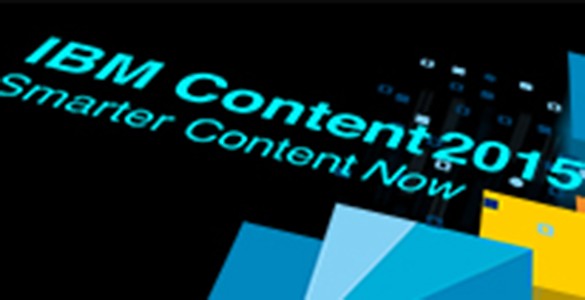I was invited and went for a half day to the IBM Smarter Content Now conference in Chicago on June 9, 2015, and wanted to share my notes with you.
It opened with Simon Bailey who told the story of how he got fired from Disney for telling a reporter he was going to be the CEO of Disney in 10 or 15 years. He used his cell phone at the end to take questions (unique idea), and this morning, he answered my question via text. He said that people should Own the Moment. His speech is similar to what you’ll see on his website. He said there are 20,000 moments in a day. It reminded me of “lovemarks” which is that Saatchi Saatchi red paper I sent around our office a few weeks ago. Disney hires people to create moments. They know what people spend on a per-family basis, and the people who walk around the park are there to bond with those people, to “create moments.”
Customer Service is Dead
Bailey said at the end that customer service is dead. “Customer Love” is in. (Our blog has some ideas for you to consider as well) He was motivational and reflected what all of us should be trying to do as organizations. And a profound quote: “Wisdom is what you get when you don’t get what you want.” This is similar to what we discuss when telling people to embrace failure: I’m really trying to say that it’s only through failing that you really learn anything significant.
It’s About Stories
The next speaker was Carter Adkinson, a VP of IBM who talked about the day’s topic, content. He said it’s all about stories, which is if you remember what Facebook said when they said they are launching their advertising platform several years ago. He talked about how every story has a shape, and stories have endings. You have to keep the customers you have and find new ones, and you do that these days with stories (content). It’s about the customer experience.
Our road — and yours — to excellence must continue around service. This conference from IBM demonstrated to me that they are building service tools to help the very difficult tasks of building relationships with lots of people using automation.
Other things I learned:
- 90% of data is unstructured, and that is where the value lies. Trying to give it structure, and then extracting wisdom (this was the theme of one of the sessions on Big Data I attended later that morning).
- Everyone is doing multi-tasking, yet we have less time.
- Russian Troll Farms. There are people who create fake reality on the internet just to cause trouble. He said you have to be a trusted source…easy to get to information. I thought, “Once we lose the trust of a client, we lose everything.” It’s like that in life, too.
- Business content is everywhere. But it is invisible. This was an interesting statement, implying that despite all the content, we just can’t see anything (similar to the Nate Silver Signal and the Noise book and, our blog on how much data can you eat.).
Carter also talked about four steps: Value Proposition leading to Purchase leading to Onboarding leading to Self Service. IBM’s Case Manager software, Navigator software and Datacap software were the ones he mentioned. I listened to Document Alchemy, a presentation on the Datacap, and it was extremely interesting.
Faxes, faxes, who uses faxes?
For example, Mark Martin talked about how faxes are not dead. This software is able to collect inputs from various sources, and deliver them electronically. Some of the things he said were from research:
- 19% more paper is being used today despite all the automation
- 42% of data come from unstructured inputs
- 13% print pdfs and then scan them back into the system
He said paper is slowing us down. You move paper, but what you are really moving is information. So that’s what Datacap does. He gave case histories, including ones from healthcare, banking and insurance. Words like “distributed capture” or “keystoning” were used and ones I learned. They are really building “smart” tools that recognize sizes, shapes and locations of things (i.e., it will learn and then remember “this is an invoice”). And everything is moving toward mobile.
Big Data Insights
The Big Data Bad Data presentation was good. It’s about data curation. A single breach of security averages $3.5M. And there are many of these (the larger ones we hear about are much more). Some of the things he mentioned we should consider about data are:
- Understand if the info fits the life cycle
- Define and enforce the overall retention policy (do we need to keep all this stuff)
- Legal requirements of keeping or dumping the data
- Throw out the trash
- Extract what we need from the unstructured
- Sanitize it.
There was a lot to think about, but what it proved is that data is sexy, and that if you are working with unstructured data, you are on the right track. Thanks, IBM, for the invitation!
If you’d like to discuss what we’re doing in B2B that relates to these topics, please give us a call. Thanks for reading.
